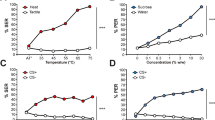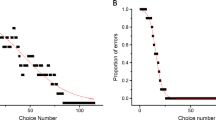Summary
Four strains of the honeybee (Apis mellifera capensis), which were selected for high (N=2) or low (N=2) performance levels in classic conditioning of olfactory and mechanosensory stimuli, were examined in two instrumental visual learning tasks. Bees were trained to coloured cardboards either at the hive entrance or at the feeding station. Positive correlations were detected between olfactory/mechanosensory conditioning and visual learning. Good and poor learners from strains selected for olfactory conditioning differed significantly in their visual learning values. These strain differences reflect genetic differences in a common learning system rather than task specific differences in sensory, motor or motivational components. Parameters that were influenced by activity of the colony (duration of stay at the feeding place, time between visits) also differed among selected strains. These effects were not due to selection. Instead, they reflect a specific genetic background produced in each strain independently of selection. The results indicate that associative learning has a genetic basis which is independent of the sensory stimuli associated with reward, the learning procedure (classical conditioning or instrumental learning) or the motor patterns used to execute the learned behavior (proboscis extension, control for flight behavior, open field orientation).
Similar content being viewed by others
Abbreviations
- US :
-
unconditioned stimulus
- CS :
-
conditioned stimulus
- PER :
-
proboscis extension reflex
- UR :
-
unconditioned response
- CR :
-
conditioned response
References
Andersen RH (1963) The laying worker in the Cape honeybee, Apis mellifera capensis. J Apic Res 2:85–92
Bitterman ME, Menzel R, Fietz A, Schäfer S (1983) Classical conditioning of proboscis extension in honeybees (Apis mellifera). J Comp Psychol 97:107–119
Brandes Ch (1988) Estimation of heritability of learning behavior in honeybees (Apis mellifera capensis). Behav Genet 18:119–132
Brandes Ch (in press) Genetic differences in learning behavior in honeybees (Apis mellifera capensis). Behav Genet
Brandes Ch, Frisch B, Menzel R (1988) Time course of memory formation differs in honeybee lines selected for good and bad learning. Anim Behav 36:981–985
Duerr JS, Quinn WG (1982) Three Drosophila mutants which block associative learning also affect habituation and sensitization. Proc Natl Acad Sci USA 79:3646–3650
Dudai Y (1988) Neurogenetic dissection of learning and short-term memory in Drosophila. Annu Rev Neurosci 11:537–563
Erber J, Masuhr Th, Menzel R (1980) Localization of short term memory in the brain of the bee, Apis mellifera. Physiol Entomol 5:343–358
Gailey DA, Jackson FR, Siegel RW (1984) Conditioning mutations in Drosophila melanogaster affect an experience dependent behavioral modification in courting males. Genetics 106:613–623
Kuwabara M (1957) Bildung des bedingten Reflexes von Pavlovs Typus bei der Honigbiene Apis mellifica. Hokkaido Univ Zool J Fac Sci 13:458–464
Lauer J, Lindauer M (1971) Genetisch fixierte Lerndispositionen bei der Honigbiene. Abh Akad Wissensch Lit Mainz Inf Org 1:1–87
Lauer JR, Lindauer M (1985) Lernprozesse im Orientierungsablauf der Honigbiene. Ein rassenspezifischer Vergleich von Apis mellifica carnica und Apis mellifica ligustica. Abh Akad Wissensch Lit Mainz Inf Org 2:1–88
Menzel R (1967) Untersuchungen zum Erlernen von Spektralfarben durch die Honigbiene (Apis mellifica). Z Vergl Physiol 56:22–62
Menzel R (1969) Das Gedächtnis der Honigbiene für Spektralfarben. II. Umlernen und Mehrfachlernen. Z Vergl Physiol 56:329–334
Menzel R, Bitterman ME (1983) Learning by honeybees in an unnatural situation. In: Huber F, Markl H (eds) Neuroethology and behavioural physiology. Springer, Berlin Heidelberg New York, pp 206–215
Menzel R, Erber J, Masuhr Th (1974) Learning and memory in the honeybee. In: Barton-Brown L (ed) Experimental analysis of insect behavior. Springer, Berlin Heidelberg New York, pp 206–215
Menzel R, Freudel H, Ruehl U (1973) Rassenspezifische Unterschiede im Lern verhalten der Honigbiene (Apis mell L). Apidologie 4:1–24
Menzel R, Hammer M, Sugawa M (1989) Non-associative components of conditioning in honey bees. In: Erber J, Menzel R, Pflüger MJ, Todt D (eds) Neural mechanismus of behavior. G. Thieme, Stuttgart New York, pp 221
Moritz RFA, Brandes Ch (1987) In: Menzel R, Mercer E (eds) Behavior genetics in honeybees. Springer, Berlin Heidelberg New York, pp 21–35
Rose R, Menzel R (1981) Luminance dependence of pigment color discrimination in bees. J Comp Physiol 141:379–388
Rothenbuhler WC (1967) Genetic and evolutionary considerations of social behavior of honeybees and some related insects. In: Hirsch J (ed) Behavior-genetic analysis. Mc Graw Hill, New York, pp 61–106
Ruttner F (1977) The problem of the Cape bee (Apis mellifera capensis Escholtz): parthenogenesis — size of populations — evolution. Apidologie 8:281–294
Sachs L (1984) Angewandte Statistik. Springer, Berlin Heidelberg New York
Seeley ThD (1985) Honeybee ecology. A study of adaptation in social life. Princeton University Press, Princeton, New Jersey
Temple BL, Bonini N, Dawson DR, Quinn WG (1983) Reward learning in normal and mutant Drosophila. Proc Natl Acad Sci USA 80:1482–1486
Tully T (1987) Drosophila learning and memory revisited. Trends Neurosci 10:330–335
Tully T, Quinn WG (1985) Classical conditioning and retention in normal and mutant Drosophila melanogaster. J Comp Physiol 157:263–277
Winston M (1987) The biology of the honey bee. Harvard University Press; Cambridge, Massachusetts
Author information
Authors and Affiliations
Rights and permissions
About this article
Cite this article
Brandes, C., Menzel, R. Common mechanisms in proboscis extension conditioning and visual learning revealed by genetic selection in honeybees (Apis mellifera capensis). J Comp Physiol A 166, 545–552 (1990). https://doi.org/10.1007/BF00192025
Accepted:
Issue Date:
DOI: https://doi.org/10.1007/BF00192025




